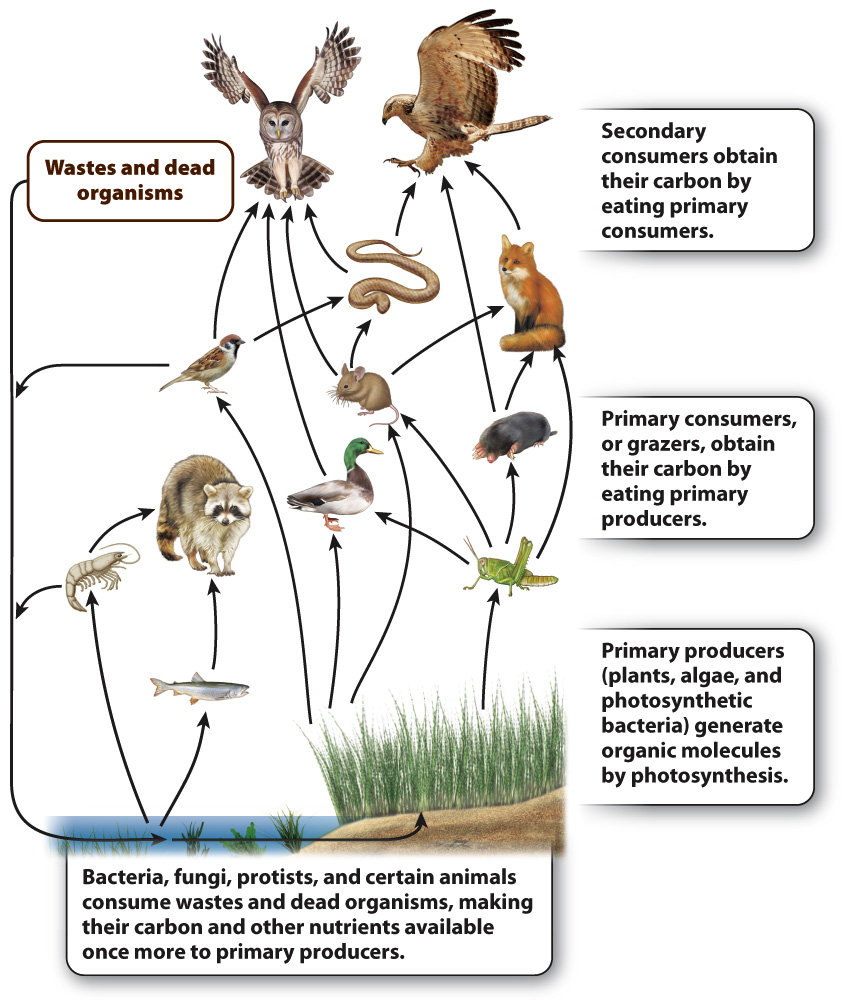Food webs trace the cycling of carbon through communities and ecosystems.
As you sit quietly by a woodland pond, the carbon cycle is at work all around you (Fig. 25.12). In the forest, plants generate carbohydrates as they photosynthesize, and algae and photosynthetic bacteria are doing the same in the pond. All of the organisms in a habitat such as a woodland pond constitute an ecological community. In Chapter 6, we called photosynthetic organisms autotrophs (“self feeders”) because they synthesize the organic molecules needed for growth and reproduction from CO2. Ecologists commonly refer to these organisms as primary producers, reflecting their position within the carbon cycle. Primary producers are the first biological reservoir for carbon once it has been taken out of the physical environment.

An insect grazes on leaves, and ducks feed on both insects and algae. Ducks and insects obtain the carbon they need for growth and reproduction from the foods they eat, and they also gain energy by respiring food molecules. In Chapter 6, we called such organisms heterotrophs (“other feeders”), and ecologists label them consumers, again with reference to the carbon cycle. Consumers include all the animals in both pond and forest. Beneath our feet, similar interactions play out on a microscopic scale, especially among the fungi, protists, and bacteria that recycle the organic carbon in soil back to CO2.
Primary consumers consume primary producers. Biologists call these organisms herbivores or grazers. Primary consumers transfer carbon drawn by the primary producers from the environment to a second biological reservoir and, by respiration, return some of the carbon to surrounding air or water.
Secondary consumers, in turn, are predators or scavengers that feed on primary consumers. In particular, animals that eat other animals are called carnivores, and these organisms may provide food for still other carnivores, generating successive tiers of consumers. Like primary consumers, secondary consumers continue the transfer of carbon from reservoir to reservoir by eating the primary consumers and returning some of the carbon stored in that reservoir to the environment through respiration. Eventually, having passed from one consumer to another, the carbon originally fixed by photosynthesis is returned to the atmosphere by the respiration of fungi, bacteria, and other decomposers that break down dead tissues. The cycle has come full circle.
522
The transfer of carbon from one organism to another is called a food chain. Because most heterotrophs within a community can consume or be consumed by a number of other species, biologists often prefer to speak of food webs, a term that provides a better sense of the complexity of biological interactions within the carbon cycle (Fig. 25.12). Food webs define the interactions among organisms in ponds, forests, and many other habitats; we discuss them in detail in Chapter 47. For now, the main point is that food webs track the passage of carbon atoms through the biological carbon cycle. Put another way, the carbon cycle underpins the ecological structure of biological communities.
The complementary metabolic processes of photosynthesis and respiration cycle carbon through forest and pond communities. Furthermore, as we discuss in the next chapter, complementary metabolic processes also cycle nitrogen, sulfur, and other elements required for life. By continually recycling materials, biogeochemical cycles, which involve both biological and physical processes, sustain life over long intervals. In their absence, life could hardly have persisted for 4 billion years.